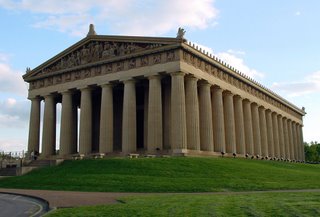The Nashville, Tennessee Parthenon. Reinforced concrete, 1921-1931.

Now that we've done the Parthenon, I thought I'd show you one of those bizarre tourist attractions that can be found only in America. We really have no great ancient art of our own, so we have to copy other people's instead. This is the Parthenon in Nashville, Tennessee. A perfectly natural place for a full-scale replica of the Parthenon, don't you think? It is the world's only other Parthenon, and I suppose we can brag about the fact that ours is in better condition than the one in Greece.
So just how does Nashville end up with a Parthenon? Well, in 1897 Nashville hosted the Tennessee Centennial Exposition, a celebration of Tennessee's 100th birthday. Now for some reason, Nashville was known as the "Athens of the South." I have no idea why this is. I actually think it's pretty funny. You might as well call Phoenix the "Venice of the Southwest." But I digress. The point is, someone came up with the crazy idea to make Nashville even more like Athens by building a replica Parthenon in honor of the Centennial Exposition. And apparently a bunch of people thought this was a stellar idea. It was originally meant to last only a year, but Nashville's citizens loved their Parthenon so much that they decided to keep it. It was rebuilt as a permanent structure in the 1920s.
This is all pretty nutty, I know, so it comes as something of a surprise that Nashville's Parthenon is so accurate. Architects were sent to Athens to study and make measurements of what was left of the original Parthenon, and a lot of the statuary was made from casts of Britain's Elgin Marbles. Parts of the Parthenon that no longer existed were re-created from drawings made by French artist Jacques Carrey back in 1674 (before the unfortunate explosion wrecked the place). Really the only major difference between their Parthenon and our Parthenon is in the materials used - Nashville opted not to go for marble, and built their Parthenon out of reinforced concrete instead. Nashville's Parthenon now even has its own 42-foot sculpture of Athena.
Today the Parthenon is primarily used as an art gallery, although it also houses a gift shop and some office space in the basement. (I wish I worked under the Parthenon.) I highly suggest you visit this website at Columbia University, which offers a number of 360 degree views of Nashville's Parthenon, in case you can't make it there in person.




1 Comments:
Americans are more Athenians than we are! Can I order two brand new Parthenons for Acropolis, too? I am planning to relive the worship of Goddess Athena and make an extra Parthenon for Christ! Athenaism Christianism Cult!
Post a Comment
<< Home